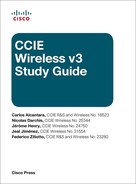How This Book Is Organized
Chapter 1, “Planning and Designing WLAN Technologies”: This chapter covers the fundamentals of WLAN design and planning. It provides the key elements to keep in mind when you are considering a new enterprise-class WLAN, from RF boundaries between cells, AP positioning, client and AP power levels, to channel plans and AP density.
Chapter 2, “Network Infrastructure”: This chapter covers the infrastructure technologies involved in preparing and setting up a wireless network. It is aimed at refreshing the Layer 2 and Layer 3 knowledge (as well as key network services) required to configure and optimize a wired network that has to support wireless infrastructure.
Chapter 3, “Autonomous Deployments”: This chapter covers the Cisco IOS Autonomous WLAN devices, specifically focusing on the technologies and features involved in wireless bridge links, using these autonomous devices in the appropriate roles. The purpose is to give you the core knowledge (and main tips) required to deploy, configure, and troubleshoot these IOS devices for wireless bridging designs.
Chapter 4, “AireOS Appliance, Virtual, and Mobility Express Controllers”: This chapter describes controller-based wireless architectures, their main components, and their functionalities. It provides the basics to get started with both theory and practice, as well as the details on how more advanced features work and how to configure them. Some of the main topics in this chapter include architectures (centralized, FlexConnect, Mesh, and so on), security settings (L2/L3 security, rogue AP management, ACLs, and so on), radio management, and more.
Chapter 5, “Wireless Security and Identity Management with ISE”: Cisco Identity Services Engine is a key component for deploying a secure wireless network. This chapter covers the protocols and concepts needed to understand and configure an access policy using ISE. In addition, it examines the most common use cases, describing configurations required to implement them.
Chapter 6, “Prime Infrastructure and MSE/CMX”: This chapter focuses on setting up and optimizing management operations through Cisco Prime Infrastructure and on integrating it with the MSE/CMX location solutions. It includes basic and advanced management options, as well as explanations on wireless location techniques and best practices. Details and clarifications on the more recent Cisco CMX solutions are provided, too, as extra content to the CCIE Wireless blueprint.
Chapter 7, “WLAN Media and Application Services”: This chapter covers the elements you need to design, configure, operate, and troubleshoot a WLAN with real-time applications. This chapter covers the fundamentals of QoS and how differentiated services are applied to wireless traffic. It also explains how differentiated services are configured for the various WLAN platforms and details what performances you are likely to expect based on your configuration.
